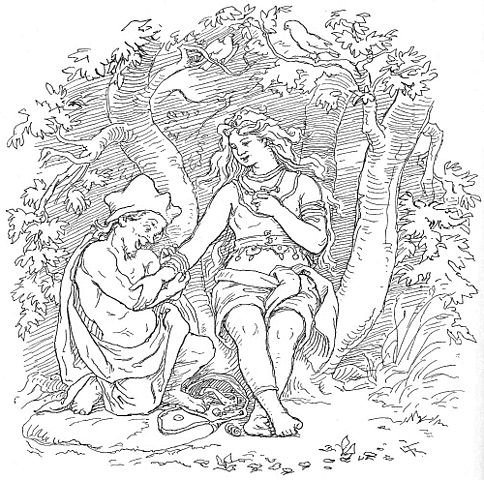Thrud is the daughter of Thor, the god of thunder lightning, winds, and rains with Sif, a goddess associated with the earth. She is one of the few survivors of Ragnarok along with her brothers Magni and Modi, Njord, the Norse god of the sea, Vidar, and Vali in Norse mythology, tasked with rebuilding the nine realms in order to usher in a new era of mankind.

Thrud, derived from the Old Norse name Þrúðr, carries the meaning of “strength.” As a member of the Aesir gods, Thrud is often recognized as both a goddess of battle and a Valkyrie, although some sources suggest that the Valkyrie named Thrud might be a separate entity.
Described as a gentle deity, Thrud is believed to embody her father’s strength while possessing qualities of beauty, charm, and magic. Despite being a relatively overlooked goddess in Norse mythology, there are indications that Thrud held significant recognition during the Viking Age.
Given the limited references to Thrud in sagas and Eddas, her exact responsibilities remain uncertain. However, considering her association with warfare as a warrior goddess or Valkyrie, it is reasonable to speculate that she played a role in determining the outcomes of battles.
Family of Thrud
Thrud, the daughter of Sif and Thor, is a sister to Modi and a half-sister to Magni and Ullr. Residing in Thrudheim, which is Thor’s domain, her very name in Old Norse signifies “strength.” The goddess Thrud is mentioned in multiple sources, and Thor himself is occasionally hailed as “the tough father of Thrud.” He is described as the one who fervently yearns for Thurd in the poem Thorsdrapa.
Additionally, the Karlevi stone on Öland, Sweden, bears a runic inscription referencing a chieftain who has accomplished “the deeds of the battle goddess Thrud,” symbolizing their prowess as a true and esteemed leader.
What is Thrud the Goddess of?
Thrud, the goddess of battle, holds sway over the outcome of conflicts. Her essence embodies the feminine power of lightning and storms, bestowing inner strength upon those who invoke her name. She is protected by Thor.
In addition to her martial prowess, Thrud shares a connection with the natural world through her mother. She is believed to be associated with the grace and beauty of willows, the steadfastness of trees, the vibrant allure of flowers, the resilience of grass, and the diverse realm of animals.
Thrud in Norse Sources
In the Prose Edda, specifically in the Skaldskaparmal book, Thrud is depicted as the daughter of Thor and is recognized as a Valkyrie. Her presence is also acknowledged on a runestone located on the island of Oland in Sweden, where a chieftain is hailed as a “battle tree of Thrud.” Furthermore, in an anonymous poem that enumerates all the Asynjur (goddesses), Thrud is mentioned alongside well-known and lesser-known deities.
The Ragnarsdrápa, a composition by Bragi Boddason in honor of the famous Viking hero Ragnar Lodbrok, describes the giant Hrungnir as the “thief of Þrúðr” (Þrúðar þjófr). However, this particular myth is not directly referenced in any other source. It is worth noting that Hrungnir is the first giant whom Thor defeats in a one-on-one duel. One of the most intriguing tales involving Thrud is found in the poem Alvissmal, which is part of the Poetic Edda.
The Tale of Alvissmal
In the poem, a black elf named Alvis arrives at her home in Thrudheim asking for Thrud’s hand in marriage. The story tells us that Thrud had been promised to the elf for something he did for the gods. Thor does not dispute the fact and tells Alvis that he was not present when the promise was made and no other god has the right to give her hand in marriage.
Thor, known for his hot temper and fierce physical power could have solved the problem instantly with his might. However, he instead decides to mess with the elf. Thor tells Alvis that despite the mistake, I will grant you my daughter’s hand if you succeed in answering all of my questions correctly. Alvíss possessed immense knowledge. So, Thor proceeds to ask one question after another, and as evening became night, Alvis shares his infinite knowledge with the god of thunder.
Just before sunrise, Thor tells Alvis that while he found his knowledge impressive, he was just stalling for time. When the sun rose Alvis turned to stone as soon as the first rays of sunlight touched him because he was a black elf, saving Thrud from getting married to Alvis. Alvissmal stands out among the tales of Norse mythology as the only story showcasing Thor’s problem-solving abilities through wit rather than relying on sheer physical force.
In different translations of Alvissmal, Alvis is referred to as the Lord of Chariots. In another version, Alvis hints at a marriage with Thrud as compensation for crafting weapons. Considering that Thor possesses a remarkable chariot, it is possible that this association is related. However, it is clear from the poem that Thor himself was not the one who made such a promise.
